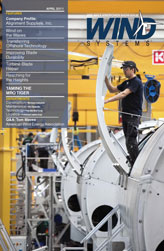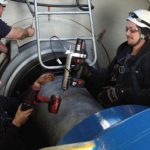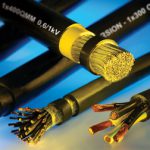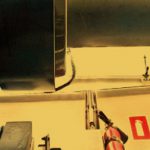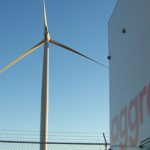With high demand for wind power and a fiercely competitive environment, a turbine manufacturer’s future success or failure hinges on its ability to deliver a reliable product to market quickly. However, failure rates as high at 20 percent within three years are raising serious doubts and forcing the industry to quickly reevaluate traditional design and manufacturing processes.
Instead of reinventing the wheel—or the blade, in this case—manufacturers should borrow best practices from the aerospace industry in order to improve industry-wide success rates. From a design and manufacturing standpoint, wind turbine blades have many similarities to helicopter rotorcraft blades and other aerospace structures. Wind turbine manufacturers, therefore, have a unique opportunity to adapt and apply the best practices that aerospace manufacturers have developed and refined over several decades. Doing so will increase their chances of success in a tough, competitive environment by reducing design lead time, improving blade durability, and optimizing design and manufacturing processes.
Composite Challenges
Composite materials are ideal for producing wind turbine blades. They dominate the wind turbine blade market with their superior fatigue characteristics, stiffness-to-weight ratio, unique ability to fabricate complex geometries, and potential for aero elastic tailoring. The ability to tailor composite materials to specific loads and other requirements is one of their greatest strengths, but it also increases the complexity of the design process. In addition, their structural complexity presents difficult challenges in optimizing design and manufacturing methods.
Most causes of turbine or blade failure can be attributed to sub-standard design and manufacturing practices that could be eliminated by adopting many of the best practices for composites design and manufacturing in the aerospace industry. A significant part of the challenge may be that nearly all composite blades today are designed on basic CAD systems intended for making solid metal and plastic parts of far less complexity than today’s sophisticated, multi-layered composites. The limited capabilities of the traditional CAD systems means that analysis and manufacturing engineering are carried out in separate and disconnected environments, creating inefficiencies and introducing the potential for error.
In the typical process, the aerodynamicist first defines the outer shape of the blade using specialized fluid flow software packages and wind tunnel testing. This design is then provided to mechanical engineers, who define the detailed design and basic ply guidelines for the blade. The CAD software has no facility for keeping track of the laminate information involved in composites design, so the engineer typically tracks this information in a spreadsheet. Figure 1
The engineer might start by defining areas of the part with similar thicknesses as zones. The zone information is usually maintained manually in a spreadsheet. Then the engineer will define a ply stack that delivers the mechanical properties required in each zone, as indicated by previous experience. Most companies involved in composite design have design rules that are used to guide this process. For example, the smaller plies may be located on the inside of the stack and the larger plies on the outside.
An analyst typically creates a finite element model from scratch to evaluate the bending strength and other characteristics of the blade. Various loading conditions are used to simulate different wind conditions, and the proposed blade design may be challenged by load-time histories to predict its fatigue strength. Next, the analyst recommends changes to the plies based on the analysis results, and the design typically goes back and forth between the engineer and analyst multiple times. With everything being manually tracked via spreadsheet, it’s a time-consuming process with a lot of room for error.
Blade Manufacturing
In the traditional blade development approach, which is very orderly and sequential, defining the manufacturing process comes next. The final shapes of the flat patterns are determined on the shop floor by expensive and time-consuming trial and error: cutting plies, laying them onto the molding tool using manual measurement, checking for distortion, re-cutting, and trying again. The complex aerodynamic shape of wind turbine blades makes it hard to predict how composite materials will conform to the mold’s complex surface. Sometimes distortion causes the material to draw away from the mold. In other cases, a ply sequence imbalance across a 3D shape generates stresses that cause wrinkling or warping. A major difficulty is developing flat patterns that will meet the ply guidelines without fabric distortion, such as bunching up on the mold. Using conventional methods, this process cannot even begin until the molding tool is built.
At this point, the normal procedure is to cut fabric plies by hand and try to fit them on the mold tool. Inevitably, a considerable amount of distortion is seen. Assemblers use darts and splices in an effort to solve the problem. The trial-and-error nature of this process means that the material is finally fit to the mold using far more darts and cuts than would be necessary if the flat pattern shapes were optimized, resulting in a weakened final product. It is also not a repeatable process. The flat patterns that result from this process are measured and used for volume production, which means that the waste is repeated on every blade built. The entire first-part process typically takes large amounts of time and consumes substantial amounts of expensive composite materials.
Applying Lessons
From a design and manufacturing standpoint, wind turbine blades have many similarities to helicopter rotorcraft blades. The loading on a wind turbine blade and a rotorcraft blade consist primarily of aerodynamic pressure loads. The speed of a wind turbine blade is much slower, so it experiences much lower aerodynamic pressures.
Taking into account best practices learned from the rotorcraft blade industry, Dassault Systèmes developed CATIA Composites Design, a Product Lifecycle Management (PLM) solution that provides a dramatic improvement over conventional CAD systems by providing a complete end-to-end solution for preliminary design, engineering detailed design, manufacturing detailed design, simulation, and manufacturing export. The similarities between wind turbine and rotorcraft blades mean that the rotorcraft blade industry best practices can be used to integrate structural zone-based modeling into the design environment or grid-based approach using analysis thickness laws or stacking sequences at the beginning of the lifecycle of the part. Either design approach saves large amounts of data entry time, which can be devoted to more productive tasks and innovation. It also becomes possible to generate conceptual solids to quickly integrate the composites part in the mock-up, enable concurrent engineering with mating parts, and even provide preliminary inputs for tooling to start working on the mold very early in the lifecycle of the structure. CATIA Composites Design can generate splices from the solid model based on the zone or grid design, while keeping full associativity between the plies and solid. It organizes the ply buildup by recording non-geometric information and creating sequence charts per company standards, material tables, and lay-up books.
The ability to design the composite lay-up within context of the complete blade assembly streamlines the design process. It also ensures a higher level of accuracy that reduces the number of physical prototypes needed to finalize the design. This in turn cuts costs, eliminates trial and error, improves accuracy, improves durability, and minimizes splices and darts. Leveraging powerful design optimization tools provides advantages such as the ability to swap ply edges to optimize drop-offs, shape plies, and re-route sets of plies along a preferred path. Figure 2
Tighter Integration
The new best practices pioneered in rotorcraft blade design substantially improve the analysis process by integrating design with finite element analysis (FEA) for fast design-analysis iterations in full associativity with the zones and plies definition. Bidirectional communications are provided between design and analysis at both the conceptual and detailed design stages. The ability to directly transfer accurate fiber angles and ply thicknesses from the design to the analysis environment improves the simulation accuracy. The ability to transfer updated design information from analysis back to design enables designers and analysts to work closely together, ensures the analyzed model matches the final structure, and prevents the specification of plies and structures that cannot be manufactured.
For example, Abaqus FEA software provides engineers with advanced, state of the art capabilities for simulating realistic composites behavior, including delamination and damage. These complex, nonlinear effects are modeled using cohesive elements and VCCT (Virtual Crack Closure Technique). The VCCT capabilities in Abaqus enable engineers to identify the overall load at which a crack initiates and to predict the behavior of the structure as the crack propagates. It also helps users understand the stability and load-carrying capacity of the composite structure after failure.
Virtual Manufacturability
Aerospace best practices also provide dedicated features to ensure that the detailed design is manufacturable and avoid trial and error on the shop floor. The lay-up of the composite plies onto the mold tool is simulated to identify areas where the part geometry will cause fabric distortion. The engineer can then add darts or splices or make other changes to the ply and receive immediate feedback on whether the changes have corrected the design problem.
The program then automatically generates the resulting pattern geometry for each ply within the CAD environment. This geometry can be exported to a ply-cutting machine to produce the patterns for prototyping, saving the time that would normally be spent cutting the patterns by hand. More important, with simulation identifying manufacturing problems in the virtual environment, the first iteration of the design should be correct or very close to correct, eliminating the need for trial and error on the shop floor. Figure 3
Composites design and manufacturing data can easily be linked to nesting systems, as well as all industry-standard laser projection systems. This approach provides the ability to preview and optimize laser projection on screen before actually reaching the shop floor, helping to eliminate trial and error. It also eliminates the need for manual measurement during the lay-up process. Close coordination with tape laying and fiber placement machine providers ensures that the process flow will be seamlessly tailored to their machines. Finally, shop floor documentation is available either as a traditional drawing-based ply book or a digital ePly book to dynamically integrate the 3D master with all associated operations and work instructions.
Reducing Failure
Composites materials are ideal for producing wind turbine blades because of their strength, light weight, and ability to be tailored to provide the precise mechanical properties needed for any blade design. But the traditional manual, sequential, and trial-and-error-based composites design process makes it difficult to take full advantage of composites’ tremendous performance capabilities due to long manufacturing cycles and inexact manufacturing processes. Now, best practices originally developed for rotorcraft blade manufacturing can be applied to composites design for wind turbine blades to enable a complete set of process-oriented solutions to design, simulate, and manufacture composite blades on a single virtual platform.
The new approach saves time and avoids errors by managing all aspects of the preliminary and detailed design in a single associative environment. The design can be optimized from a manufacturability standpoint in the virtual environment to save time and material on the shop floor. Bidirectional links to powerful analysis tools reduce the time required to meet the design specifications while minimizing weight and cost. Links are provided for the digital design information to drive pattern cutting, laser projection, and nesting, etc. All in all, the new approach improves performance and quality while reducing development time and costs.



















